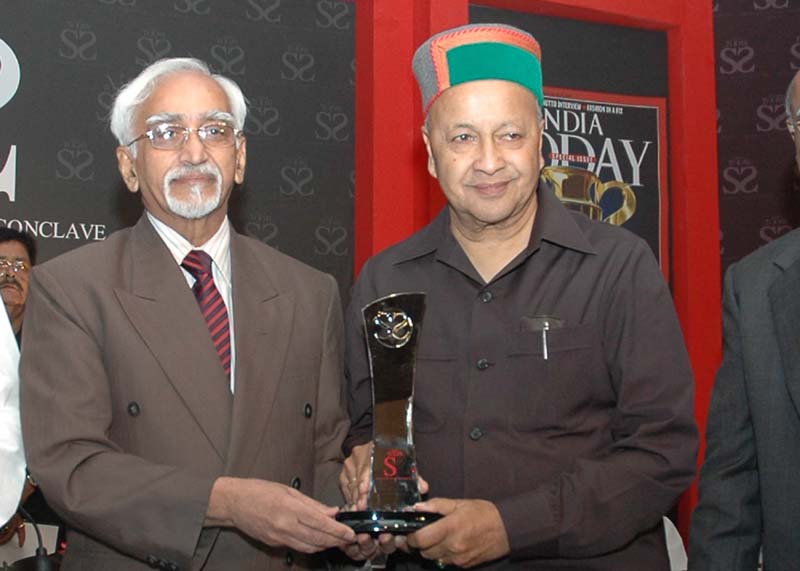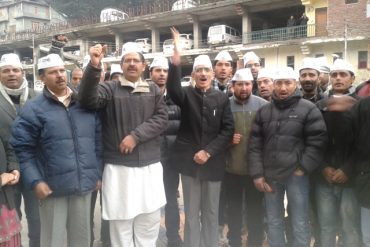Himachal Pradesh has been declared best in poverty reduction in the country by India Today Group in its Annual Survey States of States 2007.
Himachal Pradesh Chief Minister Mr. Virbhadra Singh was given Award by Vice-President
Mr. Hamid Ansari in States of States 2007 function organized at Hotel Taj Man Singh at New Delhi today.
Himachal has also been adjudged third best State for consecutive fourth year in the country by India Today Group.
According to survey, poverty has decreased 18.80 percent in the State last one year.
Among big States, Himachal Pradesh has less than 10 percent of its population having below poverty line.
Himachal is also declared second Most Peaceful State in Northern States
and fourth most peaceful State in the country.
Up above that Himachal has been adjudged second best State in the country in Health, Education, Infrastructure, Consumer Market and Budget and Prosperity
in the category of big States.
The State has been ranked third in investment environment.
Text of Vice President Speech:
Following is the text of the Vice President’s address:
“It gives me great pleasure to address the Fifth India Today State of States Conclave. I particularly commend the India Today Group for systematically building up quantitative reference points for debate and policy making on a range of social and economic development themes.
He particularly commend the India Today Group for systematically building up quantitative reference points for debate and policy making on a range of social and economic development themes.
The focus of the State of States Report this year, ‘Inclusive Growth’, is timely. One cannot but be struck by the fact this issue has continued to dominate every critique of governance in India for over a century. It was at the 9th Session of the Indian National Congress at Lahore in 1893, that Dadabhai Naoroji commented, and He quote: “The greatest question before you, the question of all questions, is the poverty of India. This will be, am much afraid, the great future trouble both of the Indian people and of the British rulers. It is the rock ahead.â€
The situation was no different five decades later, as is evident from Palme Dutt’s observation in 1946: “India is a country of poor people. But it is not a poor country. Between these two lies the problem of the existing social and political order in India.â€
Thus a century after Dadabhai Naoroji, ‘the rock’ continues to exist and portends ‘the great future trouble’. The poverty of Indian people is still the ‘question of all questions’.
The macro-economic figures of the Indian economy appear good. We have had a real GDP growth of 9.4 % for 2006-07 and an exchange rate per capita GDP of $880; in Purchasing Power Parity terms, the per capita GDP climbed to around $4000. Our savings and investment rates have increased, there was a gross FDI inflow of $19.5 billion in 2006-07 and good reasons exist to believe that there have been productivity and efficiency improvements.
The evident contradiction perplexes observers and leads to two questions:
· What does this mean for a large segment of our population?
· What is the true wealth of our nation? Is it national income and material wealth? Or are the people of India, our true wealth?
If the latter, the only measure of national progress should be the quality of life of our people.
The recently published report of the National Commission for Enterprises in the Unorganised Sector vividly portrays the extent of poverty and vulnerability of a vast section of our people. The sense of satisfaction at the macro-economic situation stands diminished with the realisation that 77% of our population, totaling 836 million people, have an income of around Rs.20; half a dollar in exchange rate terms, and two dollars in PPP terms. This poor and vulnerable segment of the Indian population represents the broad category within which the dynamics of poverty alleviation plays out.
The poor are not homogenous. There are movements across sub-categories. Thus, the sub-category of extremely poor and poor, whose expenditure per day is less than Rs.12, have reduced by one third from 30.7% of the population in 1993-94 to around 22% of the population in 2004-05. But those who moved out of such grinding poverty have graduated to the next sub-category of those who are marginally poor and vulnerable and whose daily expenditures constitute less than Rs.20 per day. Indeed, this is poverty alleviation, but in a technical sense. We must ask as to how the well being of a person changed on a rise in expenditure from Rs 12 to Rs. 20 per day? At the other end, the middle and high-income categories have also roughly increased by about one third, from 18% of the population in 1993-94 to around 23% of the population in 2004-05.
While all citizens contribute to the national effort, in public perception there are two Indias – an India focused on wealth accumulation and another India focused on poverty reduction. We have a situation where the richest 10% of the population account for slightly less than 30% of the share of expenditure and the poorest 10% of the population account for less than 5%. Thus overall economic growth of the country has not yet translated itself into fair distribution of the fruits of development. Wealth accumulation at the top has been more impressive than poverty reduction at the bottom. The challenge is to accept that wealth accumulation and poverty reduction are two sides of the same coin and need to be addressed together.
The debate so far has been mainly concentrated on income poverty and inequality. It is held that economic development leads to poverty reduction and eventually to human development. While the broad causality of this is true, the extent of impact is dependent on the income distribution pattern of a country. If, as in India, the richest segment of the population captures a larger share of the economic development, the extent of poverty reduction would be lower for the same quantum of economic development.
More than income inequalities, what are particularly worrisome are the stark human development inequalities that adversely impact upon life chances and capabilities of our people. These can be grouped under four heads:
1. Ability to survive: the life expectancy and child mortality issues;
2. Access to basic health care, especially for the most vulnerable;
3. Access to education and human resource development initiatives;
4. Gender issues and the empowerment of women.
We have many examples from around the world and within the country where public policy choices have ensured better human development outcomes than warranted by the level of economic development. This was done through a conscious focus on income distribution patterns and ensuring that public spending on basic health and education remained high.
How does India rank on these parameters? Public expenditure on education in India is around 3.3% of GDP and on health is around 1.2% of GDP. This is low by any standards, and especially for the extent of poverty that exists in India. Much more needs to be done.
Inequalities in our society have other markers too. These pertain to disadvantaged groups and minorities, to the place of residence such as the urban-rural divide, to regional disparities in development. Each of these acts as inequality multipliers by negating substantive freedoms and life chances for individuals. Some of these were analysed in depth in the India: Social Development Report published last year by the Council for Social Development, New Delhi. The Report also sought to develop a Social Development Index and classify 20 of the large states of the country on the basis of six component indices – demography, healthcare, basic amenities, education, unemployment and poverty, and social deprivation.
These are not esoteric philosophical or economic issues. They are vital political themes that find a strong resonance in the basic principles of our polity. Article 37 of the Constitution defines the application of the Directive Principles of State Policy as “fundamental in the governance of the countryâ€. Article 38(2) states that: “The state shall, in particular, strive to minimise the inequalities in income, and endeavour to eliminate inequalities in status, facilities and opportunities, not only amongst individuals but also amongst groups of people residing in different areas or engaged in different vocations.†Article 39 also calls on the State to direct its policy towards securing that “the citizens, men and women equally, have the right to an adequate means of livelihood†and that “children are given opportunities and facilities to develop in a healthy manner and in conditions of freedom and dignityâ€.
Mahatma Gandhi accepted that his ideal of equal distribution is not realizable and advocated equitable distribution as an achievable goal. This could be one parameter for assessing the “State of Statesâ€. Inclusive growth could thus be the subtext of all of our developmental efforts. I thank the organisers of the Conclave for inviting me, and wish it all success. “






Congratulations to all Himachalies.
It is not a surprise. We had been better even in the past also. The great efforts of Dr. Y.S. Parmar in the creation of Himachal Pradesh that has made it possible to percolate the central assisted programmes and funds in a better way in this hilly state. Later leaders has added only to regional biases and favoritism.
The image of state in the recent years is eroded by increasing the use of money and muscle power in politics. Corruption CD and dance parties with call girls has completely exposed our corrupt politicians and beaurocrates.
But I have a firm belief in the people of Himachal Pradesh, they won’t allow this happen in future. Quality of life in all aspects is better in this hill state except the political concentration and patronage, which is a worrying factor to each individual of the state.
it is good positive new, people will stand against corruption, nepotism,and fight for more democratic right, more sharing of power,in dignify and respectful way,,more educated people will come forward to clean the state from corruption,middlemen and influence of liqour and bad capitalism,,